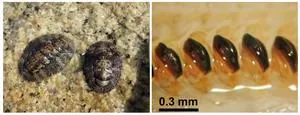
Breakthrough Discovery: Protein Revealed to Control Iron Accumulation in Chiton Teeth
2025-09-18
Author: Siti
Unlocking the Secrets of Chiton Biomineralization
In a groundbreaking study, researchers are unraveling the incredible ways in which chitons—a unique type of marine mollusk—regulate iron buildup in their teeth. These remarkable organisms, often found in rocky coastal areas, utilize a specialized feeding organ called a radula to scrape algae off surfaces. Notably, they deposit the iron-based biomineral magnetite onto their radular teeth, which not only makes them resilient but also allows them to effectively grind down tough rock surfaces.
The Quest to Understand Tooth Formation
Although the process of tooth formation in chitons is notably intricate, the specific molecular mechanisms that regulate magnetite deposition have remained a mystery—until now. A dedicated team from Okayama University in Japan, including Associate Professor Michiko Nemoto and a group of talented researchers, has published a pivotal study shedding light on this phenomenon, detailed in an August 2025 edition of Science.
Introducing RTMP1: The Key Protein
The researchers' exploration led to the discovery of a protein called radular teeth matrix protein 1 (RTMP1), a crucial player in the mineralization process. By examining the protein profiles of different chiton tissues, they identified RTMP1 and its homologs present in several chiton species, marking a significant milestone in understanding how these organisms synthesize magnetite.
How RTMP1 Transforms Tooth Development
Dr. Nemoto emphasized the implications of their findings: "Magnetite is widely used in technology, from hard drives to medical imaging. Unlike current methods of synthesize magnetite, which can be hazardous, RTMP1 offers a potentially safer and more eco-friendly alternative for production." The study tracked RTMP1’s expression through various stages of tooth development, revealing its significant role during iron oxide deposition.
A Unique Mechanism at Play
Localization studies demonstrated that RTMP1 homologs were active before iron was introduced, suggesting they prepare the tooth structure for mineralization. Following iron transport to the cusp, iron oxide formed at the sites where RTMP1 was concentrated. Interestingly, the timing and expression patterns of RTMP1 varied between species, likely reflecting their unique tooth morphologies.
Implications of This Research
Notably, when RTMP1 activity was suppressed in one species, Acanthopleura japonica, mineralization significantly decreased, illustrating the protein's central role in tooth hardening. These discoveries not only highlight the evolutionary ingenuity of chitons in managing essential minerals but also open up new avenues for applications in various fields including biotechnology and medical research on iron-related diseases.
The Future Is Bright for RTMP1
Dr. Nemoto concluded, "RTMP1 could propel innovations in technology by aiding the precise patterning of metal oxides, which is essential for creating advanced sensors and memory devices. Furthermore, this protein holds promise for unraveling the complexities of iron metabolism in the human body, illuminating pathways related to disorders like cancer and neurodegeneration."

 Brasil (PT)
Brasil (PT)
 Canada (EN)
Canada (EN)
 Chile (ES)
Chile (ES)
 Česko (CS)
Česko (CS)
 대한민국 (KO)
대한민국 (KO)
 España (ES)
España (ES)
 France (FR)
France (FR)
 Hong Kong (EN)
Hong Kong (EN)
 Italia (IT)
Italia (IT)
 日本 (JA)
日本 (JA)
 Magyarország (HU)
Magyarország (HU)
 Norge (NO)
Norge (NO)
 Polska (PL)
Polska (PL)
 Schweiz (DE)
Schweiz (DE)
 Singapore (EN)
Singapore (EN)
 Sverige (SV)
Sverige (SV)
 Suomi (FI)
Suomi (FI)
 Türkiye (TR)
Türkiye (TR)
 الإمارات العربية المتحدة (AR)
الإمارات العربية المتحدة (AR)